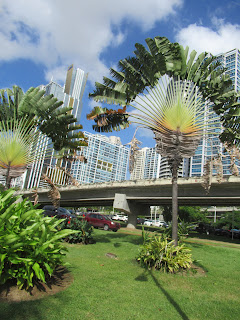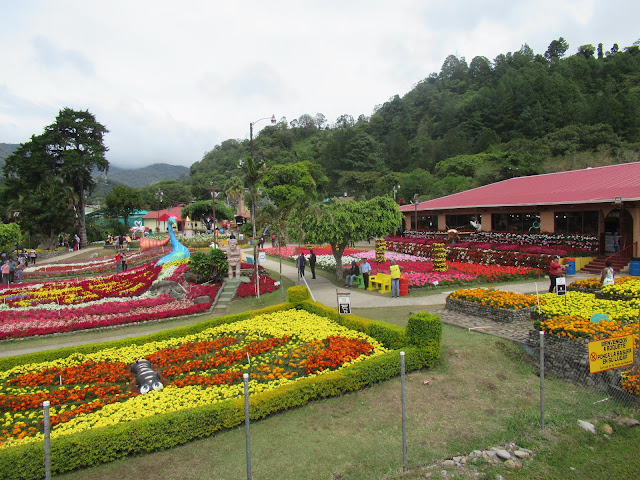This year´s southern summer vacation
was to Panama and Costa Rica.
Costa Rica is here.
After 7 hour flight from Santiago we arrived in Tucomen Airport, some 20 km and a $30 taxi ride (in dollars or Balboas, $1US=1PAB) from Panama City, home to about 1.5 million of Panama's 4.2 million people. Our hotel, the Radisson Decapolis, was in the main business district just off of the Inter American Highway, Panama's highway 1.
The next morning, after an American and/or Panamanian and/or Continental breakfast at the hotel buffet, we went for a walk along the Cinta Costera, a pedestrian and bicycle path on the seaward side of the Inter American toward the Casco Viejo, the old quarter. On the map below our hotel is marked with an H, the Casco Viejo is CV, and the Biomuseo and the canal locks at Mira Flores, discussed later, are at the map's bottom center and upper left, respectively.

Views of the city from the Cinta Costera
The obligatory "proof we were there" photo.
The 3+ km walk to the Casco Viejo turned out to be a bit much, given the 90 degree temperature and the tropical humidity, but we made it--and rested and re-hydrated in the shade of Plaza Bolivar.
...but Bolivar was looking the other way.
The Casco Viejo (Old Quarter) founded in 1673, was not the first Panama City. The original, founded, in 1519, became rich and populous as a transfer point for Peruvian gold and silver destined for Spain. And wealth attracted pirates. In 1671 Henry Morgan and 1400 followers attacked and destroyed the city. The ruins, called somewhat confusingly. Panamá viejo (Old Panama) are now a UNESCO World Heritage Site. The new city, now the Casco Viejo, was established 3 yeas later some 8 km to the southwest.
With the building of the canal and expansion of the modern city, the Casco Viejo fell into ruin and disrepair, but redevelopment is underway and the quarter is now a major tourist attraction. The narrow streets are filled with souvenir shops and Panama hat stores, restaurants, and business offices.


With the building of the canal and expansion of the modern city, the Casco Viejo fell into ruin and disrepair, but redevelopment is underway and the quarter is now a major tourist attraction. The narrow streets are filled with souvenir shops and Panama hat stores, restaurants, and business offices.


The San Francisco de Asis Church.

Souvenir and hat shops fill the streets; I bought a hat.
The Convento de Santo Domingo with its chapel, built after the fire that destroyed the convent.
Street vendors. And a nice mural in the parking lot next door.
Not all of the Casco has been rehabilitated, and there is an anti-gentrification movement to protect low income renters. The photos below show the northern section of the Casco's Avenida Central, beyond the tourist zone.


But there too, some of the buildings have been cleaned up
While awaiting the first ship's arrival we saw the canal museum.
It is well done and quite complete covering everything from Panama's geology, flora and fauna, to the history of building the canal.
And there is a interactive ship's bridge where you can guide it through the canal.
The first ship through was the 980 passenger Crystal Serenity,

followed an hour later by the 700 passenger Seven Seas Mariner, this time in the lock nearest us.
After seeing the canal, it was time to eat so we asked the taxi driver to take us to the Mercado de Pescados, a huge open-air seafood dining hall with a dozen or more restaurants. On the way he and I chatted about seafood, a favorite of both. Upon arrival he insisted in personally taking us to the "very best" of the restaurants, Ceviche Loco.
Where I ordered, and with great pleasure consumed, the Pulpo a la Costeña (octopus coastal style) which was braised in coconut cream with sweet peppers and on the side, yuca frita al mojo (fried yuca with garlic and chile). Delicious! The best restaurant meal in recent memory (and better than anything I ate in Italy in September)😋.
Alejandra was somewhat less enthusiastic.
On our final full day in Panama City we went to the Biobmuseo.
The museum, housed in this remarkable building designed by world-renowned architect Frank Gehry, and developed with assistance from the Smithsonian, focuses on Panama as the bridge between the North and South American continental biotas.
This room is filled with life-size statues of animals that crossed the bridge, beginning 4.2 million years ago; Proboscideans, bears, cats, canines and others moving into South America while opossums, monkeys, armadillos, carnivorous flightless birds, and etc. crossed into N. America.
And on the ground floor, the history of Panama is presented on the pillars.
While we were there there was also a temporary exhibit on Aji, chile peppers; their varieties and uses around the world. Alejandra and the exhibit's docent made friends.
Below, a selection of chiles from the "relatively" mild jalapeño to the infamous Carolina reaper, with their Scoville heat units.
It's a marvelous museum. For more, see it's web site.
It's a marvelous museum. For more, see it's web site.
That evening we went back to the Casco Viejo for dinner at a restaurant featuring Panamanian comida tipica and folk dances.
The cathedral that night.


The following day we left Panama City on a bus for David, in the Province of Chiriquí, about 60 km (37 mi) from the border with Costa Rica, and 360 (225 mi) west of Panama City. The 8 hour bus ride took us along the coastal lowlands, tierra caliente of scrub forest, savannas and pastures. Interesting to the geography buff; not so much to others.
But David, Panama's third largest city at around 150,000 pop and growing commercial center, was just an overnight stopping point for us. Our destination was the mountain town Boquete, 40 km (25 mi) north and 1200 meters (4000') higher. So after a pleasant evening in the City Plaza Hotel we took the local bus to Boquete.
Boquete is a popular site for Panamanian and international tourists, largely because of its temperate year round climate and its amenities: excellent hotels, restaurants, and shops. These attract, and are the result of, an active community of some 3,000 retired N. American and European ex-pats, who patronize and have started businesses, a community theater, and even a non-commercial web site (in English) with forums for everything from "quilters and knitters" to "motorcycle riders."

We stayed at the Hotel Valle del Rio, and our room was overlooking a river, abet a small one. It's just past the lawn.

The hillside we saw from out terrace was planted in coffee and had some marvelous birds. This is a red-legged honey creeper (photo credit) and below, a blue-grey tanager (credit).

The 10 minute walk to town was pleasant and far enough to eliminate trafic noise.

Among Boquette's attractions are souvenir shops, some with nice dresses.

And good restaurants serving international and up-scale Panamanian food.

And a church; several in fact.
Luckily we were there during the annual Feria de Flores (Flower Fair).

The Río Caldera flows through the town.
There are, of course, a variety of tours available, ranging from white-water rafting and canopy to bird watching. We chose a morning of bird watching. The company Bouete Tree Treck has a hotel and headquarters 6 km or so above the town at 1,700 meters (5,600 feet) where they took us in their van.

The area is in cloud forest, where you can expect a light mist (or more) every day and where plant growth is exuberant.

We walked a little above the hotel with our knowledgeable guide, but didn't see much.
So he took us to another area where there were a dozen or so humming-bird feeders.
There we saw 5 species of humming-bird.




The one on the right is not even a humming bird, but a competitor. Rather than suck out the flower's nectar, it bites through the base and steals it with out pollinating.
The next day we returned to David and took a bus to Costa Rica.








































No comments:
Post a Comment